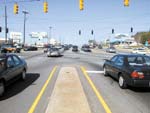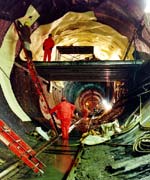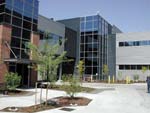
|
|
|
|
 |
|
|
|
|
|
Exhibition: Me, Myself and Infrastructure: Private Lives and Public Works in America at the National Building Museum
by ArchNewsNow October 4, 2002 Me, Myself and Infrastructure: Private Lives and
Public Works in America, an exhibition
that explores the infrastructure of a thirsty, car-crazy nation, opens today at
the National Building Museum in Washington, DC. From a consumer’s eye view of the built environment, Me, Myself and
Infrastructure brings civil engineering close to home through a series of
settings that evoke everyday places, including a
coffee shop, an office cubicle, a living room, and a big-box store. The show,
which will be on view through February 16, 2003, is presented in conjunction with the 150th anniversary of the American Society
of Civil Engineers (ASCE). In describing why an
exhibition about civil engineering is so important to the public, curator Greg
Dreicer, co-director of Chicken&Egg Public Projects Inc., says: “One-third
of the world’s population lacks access to safe drinking water. One-half lacks
the sanitation systems that keep things flush in the United States. You’d think
that these facts would lead Americans to worship their civil engineers. Why
don’t they? Because civil engineers do their job too well. They make it seem
too easy and natural.” “Me, Myself and
Infrastructure” examines public expectations and demonstrates how our everyday
lifestyles and infrastructure are inseparable, and sheds light on the hidden engineered systems that facilitate our daily lives, such
as electrical power and water treatment, by asking six essential questions: Who’s responsible? The journey begins on a mail box-lined road introducing the people
behind suburban life in Washington, D.C. – the myriad of individuals and
organizations with which civil engineers work in the complex process of
infrastructure decision-making. Visitors will be encouraged to consider whether
current sprawling development patterns dictate where they live, or whether
their personal lifestyle choices actually create sprawl. Is it safe?
By taking visitors virtually across streets in Atlanta, New York, and Portland,
Oregon, this section looks at the infrastructure behind pedestrian and
vehicular traffic, illustrating how civil engineers minimize risk and heighten
safety awareness. Why so big?
The link between home and infrastructure – the hidden yet massive engineered
systems needed to support the activities that take place in our living rooms. Is it available? An analysis of the essential ingredients of a typical coffee shop –
water supply and water treatment – examining how even a cup of coffee and a
bagel are engineered products. How much does it cost? Set in an office environment, the focus here is on
the costs and environmental impact of producing, using, and disposing of
computer equipment and other office products. How long will it last? The final question considered reflects on the
durability and disposability of materials and structure – the issues that
revolve around the permanence of infrastructure and the products it delivers –
explored by “shopping” in a big-box discount store. “Me, Myself
and Infrastructure,” which debuted earlier this year at the New-York Historical
Society in Manhattan, was developed by Chicken&Egg
Public Projects, Inc., and designed with Boym
Partners, Inc. The National Building Museum’s presentation was organized by
Ramee Gentry, coordinating curator, and Cathy Crane Frankel, director of
exhibitions. The show is underwritten by
the ASCE and is made possible by the support of the ASCE Foundation, The
Elizabeth & Stephen Bechtel, Jr. Foundation, and Charles Pankow Builders,
Ltd. Founded in
1852, American Society of Civil Engineers represents 130,000 civil engineers worldwide and is America’s oldest
national engineering society. The National Building Museum, created by an act of Congress in 1980, is America’s premier cultural institution
dedicated to exploring and celebrating architecture, design, engineering,
construction, and urban planning. Since opening its doors in 1985, the Museum
has become a vital forum for exchanging ideas and information about such
topical issues as managing suburban growth, preserving landmarks and
communities, and revitalizing urban centers. |
(click on pictures to enlarge)  (Chicken&Egg Public Projects, Inc.) Who's responsible? A suburban home in Loudoun County, Virginia. Suburban life requires a coalition of individuals and organizations with which civil engineers work in the complex process of infrastructure decision-making. (Jim Sichinolfi) Is it safe? A busy intersection in Atlanta, Georgia. A walk across the street is an engineered activity. (Chicken&Egg Public Projects, Inc.) Why so big? Each cell phone is part of a worldwide civil engineering and telecommunications infrastructure. Each cell phone owner shapes infrastructure through participation in the institutions that determine public policy. (Ted Dowey) Is it available? Construction of City Tunnel No. 3, Queens, New York, 1999. The tunnel measures up to 24 feet in diameter, and will deliver a maximum of 1.2 billion gallons of water daily (although it will not be completed until 2020, a portion was put into service in 1998). (Andy Craw/Washington County Communications (Oregon)) How much does it cost? Microchip fabrication plant. The relationship between built and natural determines the essential cost of technologies, from highways to the monitors glowing on millions of desks. (Chicken&Egg Public Projects, Inc.) How long will it last? Life span is an engineered product, but the work of civil engineers is only one of many factors that determine durability. In the end, the life of infrastructure depends on how people use it. |
© 2002 ArchNewsNow.com